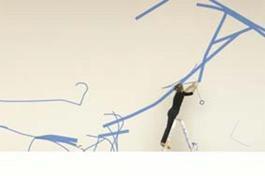Christine Hiebert
dal 12/5/2005 al 30/10/2005
Segnalato da
12/5/2005
Christine Hiebert
Pinakothek der Moderne, Munich
RoundTrip. A monumental wall drawing in the second floor, a 25-meter circular space, bounded by a transparent glass ceiling and white walls more than 5 meters high. Large-scale wall pieces have been a central theme of the artist since 2000. She observed the movement of light and shadow, she analyzed the various perspectives and intersections of the museum's architecture, and finally set her first mark on the white wall, in the form of a blue line.

RoundTrip – A wall drawing for the Pinakothek der Moderne, 2005
Curator: Corinna Thierolf
The Pinakothek der Moderne will exhibit a monumental wall drawing by the
American artist Christine Hiebert. Her work is being presented as a
first solo museum exhibition in Europe. Large-scale wall pieces have
been a central theme of the artist since 2000. Her drawing tool of
choice is bright blue adhesive tape – a common material used by
housepainters in the U.S.
Arriving in Munich with this light baggage, and without any sketches or
a plan of a finished work in mind, Christine Hiebert came to the
Pinakothek der Moderne in April 2005. Her destination: the second floor,
a 25-meter circular space, bounded by a transparent glass ceiling and
white walls more than 5 meters high. Until now, the space has only
rarely been used for the presentation of art, as its monumental
dimensions, dazzling brightness and curved walls are not suited to
classical paintings or sculpture. We commissioned Christine Hiebert to
develop a space-related work in this unexploited area.
For the artist, the emptiness of the white walls and the undefined space
was initially as barren as fallow land. She explored the space. She
observed the movement of light and shadow; she analyzed the various
perspectives and intersections of the museum’s architecture – and
finally set her first mark on the white wall, in the form of a blue
line.
This line was the starting point of the world Christine Hiebert
developed. Each subsequent line was laid down in response to the logic
of the previous ones. And in the manner with which she built up the
space – running, observing, waiting, with highly sensitive feelers, so
to speak – her drawn lines manifest her encounter with the space. The
result leads us beyond the architecture, yet back into it in a
continuous "round trip". From almost nothing she has created a
substantial force in this space. The drawing opens it up, vitalizes it
and unleashes a presence that seems to have lain dormant in the
previously barren rotunda. Hunters set their dogs free in unknown
forests in order to find their way; here the artist lets her blue line
loose. For Christine Hiebert the words of Hilde Domin ring true: "I set
my foot in the air, and it lifts me up".
Christine Hiebert’s wall drawing is on view at the same time as the
installation "Untitled (Rotunda). A Sculptural Project for the
Pinakothek" which was developed by the American artist Fred Sandback
(1943-2003) shortly before his death. The work consists of yellow, blue
and black woolen cords that run along the vertical edges of the pillars
and continue in horizontal lines along the ceiling to form a series of
gate-like passages. The installation enters into a calm and restrained,
yet strong symbiosis with the rotunda space, which the artist
investigated with his seismographic exactitude, as did Christine Hiebert
as well. Both artists, also are allied through their use of ordinary,
almost valueless material. They turn it into a "three-penny toy" (Henri
Matisse, referring to the paper from which he made his cut-outs) and
create works from material whose original function is barely evident.
The ephemeral nature of their work further connects the two artists: at
the end of the exhibition each installation will be dismantled. As a
nomad’s tent leaves only a hole in the earth when its inhabitants move
on, Fred Sandback’s piece will leave only holes in the floor. The cords,
no longer taut, are then coiled up and put into storage until the next
installation. Christine Hiebert’s adhesive tape will be removed from the
walls at the end of this exhibition, which underscores the
presentation’s uniqueness. The nature of her site-specific work is not
to recreate, but to create anew – always investigating her experience of
the present.
Fred Sandback’s "Untitled (Rotunda)" is a donation by the American
Patrons of the Pinakothek der Moderne. The realization of Christine
Hiebert’s installation "RoundTrip" was made possible by a generous
contribution to the American Patrons of the Pinakothek from the Fifth
Floor Foundation, New York.
About the artist:
Christine Hiebert is a major contemporary artist in the field of
drawing. Born in Basel in 1960 to American parents, she has lived in the
USA since 1964, today in Brooklyn. She studied graphic design in
Philadelphia, followed by painting at Brooklyn College. From childhood
on, her urban life was complemented by lengthy stays in the rural
Midwest and various American national parks, as well as the countryside
in France and Italy. In the late 1980s, she turned her focus to drawing.
Works on paper were characterized by pencil and charcoal marks scattered
on empty white sheets of paper- abstract-lyrical analogies to
explorations of unknown topographies and cities. Aside from these
drawings- many of them large-format- she has, since 2000, become engaged
in site-specific works in public spaces.
Christine Hiebert’s works are included in the collections the Museum of
Modern Art (New York), the Metropolitan Museum of Art (New York) and the
Fogg Museum (Massachusetts, among others), among others. Her most recent
solo exhibitions were held at the Margarete Roeder Gallery (New York /
Cologne), at Gallery Joe (Philadelphia) and at Victoria Munroe Fine Arts
(Boston).
Photos: Haydar Koyupinar
Pinakothek der Moderne
Kunstareal Barer Str. 29, 80799 Munich



